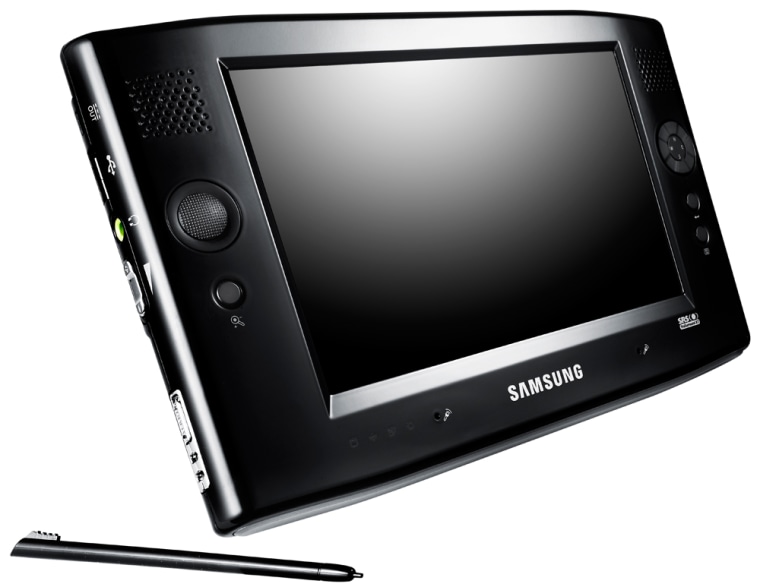Just what the world needs — another tablet computer. Only this time they've shrunk and been reborn as ultramobile PCs. (Or, if you're Microsoft, which created this new format: Ultra-Mobile PCs.)
Samsung's Q1 is one of the first of these new ultra-portables to hit the market, beginning today, and it's one nifty machine. Unlike their predecessors, these devices could be a big hit — particularly if the price shrinks as well.
Sizewise, an ultramobile PC is bigger than a PDA, but smaller than a traditional laptop. Unlike PDAs, these devices are full-functioning Windows computers; unlike most laptops, however, there's no built-in keyboard. Data is input instead through a touch screen.
Why a new device? Well, tablet PCs were never really embraced by the majority of the computer-buying public. Not willing to give up on the idea completely, Microsoft worked with some partners to create a new, smaller tablet form factor, with the aim of a much lower target price as well. Before the UMPCs were unveiled at CeBIT in March, the devices were known by the codename "Origami."
(MSNBC.com is a Microsoft - NBC joint venture.)
Inside their plastic shells, UMPCs run on the latest version of Windows XP for tablets, with sophisticated processors, lots of memory and storage plus lots of mobile-ready technologies built inside. Each UMPC must have a display no bigger than 7-inches, weigh no more than 2 pounds and be Wi-Fi (802.11b/g) and Bluetooth enabled, with USB 2.0 port(s) for connecting devices and peripherals. Manufacturers can then stack on extras, such as a TV tuner, GPS or camera.
Perfect size
Samsung's Q1 is a promising start for the UMPCs. It’s a slick machine — glossy black with a beautiful 7-inch color touch screen, a 900 MHz Intel Celeron-M ULV processor, 512MB of memory and a 1.8-inch, 40 GB hard drive. It measures roughly 9 by 5.5 by 1 inch and weighs 1.7 pounds. The internal, rechargeable battery lasted a little more than 3 hours per charge. Optional larger capacity batteries are available but they add weight and bulk.
At this point, I must admit that I have never been a fan of tablet computers. The way I use a computer, a laptop serves my needs perfectly. So, when I heard Microsoft had developed a new kind of smaller tablet, I was not overly excited. But after picking up the Q1 and actually using it, I’m beginning to change my mind.

First of all, the form factor. It’s smaller than any tablet PC I’ve had the chance to play with — but a whole lot larger than Nokia’s little 770 Internet tablet. (The Nokia should be a lot smaller, it has no hard drive.) The Q1 looked large to me at first glance, but after two minutes I began thinking that the size is perfect.
Connectivity has been perfect, so far. I was able to attach the Q1 to my wireless network and surf the Internet within seconds. The Wi-Fi and Bluetooth wireless features seem to work perfectly.
Navigating the Q1 takes about 60 seconds to learn. If you’re like me though, mastering it might take a lifetime.
Two key programs in the included Touch Pack software suite from Microsoft are Program Launcher, a kind of organizing/launching screen in addition to the standard Windows desktop and DialKeys, a thumb keyboard which pops up on the bottom corners of the screen. There is also a new Windows Media Player Skin, a utility to more easily modify Windows settings — and even a version of the ever-popular Sudoku.
I was able to eek out both words and URLs using the on-screen keyboard (I used the built-in stylus) and that silly-looking but quite useful DialKey feature. For longer documents, I would prefer one of those $100 fold-up, portable Bluetooth keyboards I’ve seen others using.
Samsung sells an optional, external USB DVD drive. If I had one, I could have easily installed Microsoft Outlook and some of the utilities I need for connectivity to MSNBC. Instead, I struggled with crossover cables and the like. I recommend that if you have programs to install it's a lot easier with the external drive.
The other benefit to the external drive is that it allows you to watch DVDs! The 7-inch screen is actually perfect for that.
Even without a DVD drive, the Q1 is perfect for watching TV if you have a SlingBox. As a matter of fact, the clever people at SlingMedia are working on a viewer just for UMPCs. The beta software included on my test model worked perfectly.

You can use a UMPC as a computer or a tablet. You can watch live TV or DVDs. You can listen to music via the built-in stereo speakers. Or maybe a VoIP speakerphone. You can use it as an electronic picture frame. You can take it from room to room or put it on a table next to your couch or your bed. Get the idea? You can probably think of hundreds of other uses for a UMPC. I’m sure Microsoft's marketing team will.
I believe there is a future for UMPCs. But I worry about the suggested retail price that Samsung has set for the Q1: $1,099. That’s way too high — even for early adapters. TabletKiosk.com is selling UMPCs made by a company named ‘eo’ which are selling for $899-999. (They begin shipping this week.) That’s only slightly little better. By comparison, the less-functional but still neat Nokia 770 sells for $360.
In a perfect world, Microsoft says it would ultimately like to see UMPCs selling in the $500-700 range. Me too. At that price, consumers will be attracted to what I consider to be a winning, new computer form factor.
Let’s hope that UMPC manufacturers do their homework and get prices down in time for the back-to-school rush and, of course, the end-of-year holiday season. If they do, Microsoft and its partners should have a winner on their hands.
